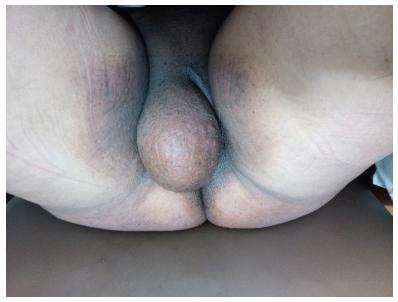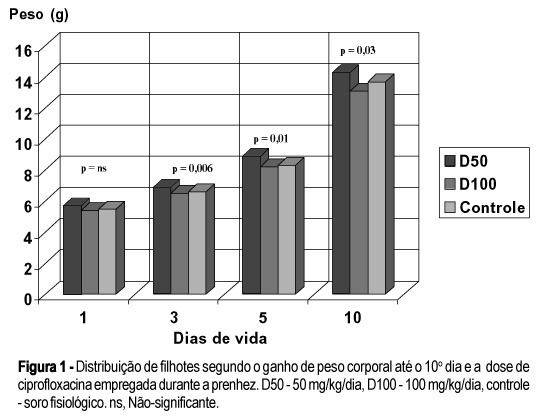Summary
Revista Brasileira de Ginecologia e Obstetrícia. 2018;40(10):647-649
The present study is a case report of vulvar lipoma. The vulva is a rare site for the development of lipomas, and the aim of the study is to determine if the current imaging modalities can diagnose lipomas correctly. A 43-year-old patient presented with a painless, slowly progressive, oval, mobile and non-tender right vulvar mass compressing the vagina and totally covering the introitus. Both the ultrasonography and magnetic resonance imaging (MRI) exams suggested the diagnosis of lipoma. Surgical excision was performed, and the histopathological examination of the mass confirmed a lipoma.

Summary
Revista Brasileira de Ginecologia e Obstetrícia. 2019;41(11):647-653
The present study aims to compare the maternal and fetal outcomes of parturients with and without a gestational diabetes diagnosis.
A case-control study including parturients with (cases) and without (control) a gestational diabetes diagnosis, who delivered at a teaching hospital in Southern Brazil, between May and August 2018. Primary and secondary data were used. Bivariate analysis and a backward conditionalmultivariate logistic regression were used to make comparisons between cases and controls, which were expressed by odds ratio (OR), with a 95% confidence interval (95%CI) and a statistical significance level of 5%.
The cases (n=47) weremore likely to be 35 years old or older compared with the controls (n=93) (p<0.001). The cases had 2.56 times greater chance of being overweight (p=0.014), and a 2.57 times greater chance of having a positive family history of diabetes mellitus (p=0.01). There was no significant difference regarding weight gain, presence of a previous history of gestational diabetes, height, or delivery route. The mean weight at birth was significantly higher in the infants of mothers diagnosed with diabetes (p=0.01). There was a 4.7 times greater chance of macrosomia (p<0.001) and a 5.4 times greater chance of neonatal hypoglycemia (p=0.01) in the infants of mothers with gestational diabetes.
Therefore, maternal age, family history of type 2 diabetes, obesity and pregestational overweightness are important associated factors for a higher chance of developing gestational diabetes.
Summary
Revista Brasileira de Ginecologia e Obstetrícia. 2003;25(9):647-654
DOI 10.1590/S0100-72032003000900005
PURPOSE: to study the effects of physiotherapeutic techniques applied by the Multidisciplinary Program of Preparation for the Childbirth and Maternity on musculoskeletal discomforts during pregnancy. METHODS: prospective cohort study, with 71 low-risk nulliparous women, distributed according to participation (study: n=38) or not (control; n=33). The Multidisciplinary Program of Preparation for Childbirh and Maternity had 10 meetings (18th to 38th week), with educational, physiotherapeutic, and interaction activities. Occurrence, characteristics, and evolution of musculoskeletal discomforts were compared by means of a specific questionnaire, both at the beginning and at the end of the program. The average of results of the initial assessment was compared through analysis of variance (ANOVA) followed by the F test. For the study between proportions in the beginning and at the end of the program the c² was used. The statistical significance was determined at 5% of limit (p<0.05). RESULTS: at the beginning of the program, 63.6% of the pregnant women of the control group and 84.2% of the study group reported musculoskeletal symptoms (p=0.05), characterized by back and posterior pelvic pain. In the control group, light intensity (18.2%) and serious intensity pain (18.4) were predominant, while in the study group, the serious was 36.8%, and the isolated or associated was 31.6%. At the end, the control group showed symptoms of serious intensity (60.6%), with daily frequency (42.4%) and length of more than 3 h (69.7%; p<0.05). The study group reported light intensity (57.9%) and bimonthly frequency (50.0%) with a maximum length of one hour (55.3%) (p<0.05). Symptom evolution was also differentiated and there were worsening in 63.6% of pregnant women of the control group and improvement in 65.8% of participants of the program (p<0.05). CONCLUSIONS: the physiotherapeutic techniques of the Multidisciplinary Program of Preparation for Childbirth and Maternity were related to a decrease in intensity, frequency and length and to a better evolution of musculoskeletal discomforts during pregnancy.
Summary
Revista Brasileira de Ginecologia e Obstetrícia. 2000;22(10):647-651
DOI 10.1590/S0100-72032000001000008
Purpose: to study the effects of ciprofloxacin on abortion percentage, maternal weight gain during pregnancy, fetal and maternal death, gross fetal malformation, newborn number, weight and neurological reflexes. Methods: we used 30 Wistar rats, divided into three groups: D50-treated (ciprofloxacin, 50 mg/kg); D100-treated (ciprofloxacin 100 mg/kg) and control group which received physiological saline per os, from the 1st to the 7th day after mating. We studied abortion percentage, maternal weight gain during pregnancy, fetal and maternal death, gross fetal malformation, newborn number and weight at 1st, 3rd, 5th and 10th day of life and newborn neurological reflexes at 1st, 3rd, 5th and 10th day of life. Results: there was no difference between groups in the number of rats that became pregnant. The same was found for maternal weight gain and newborn number. There was a difference in newborn mean weight on day 3rd, 5th and 10th (p = 0.006, 0.01 and 0.03, respectively). The D100 newborn group was the one with less weight gain up to the 10th day of life. We found a significant difference (p = 0.002) in the newborn orientation reflex on the 1st day of life, that disappeared afterwards. No abortion or gross malformation was found in this study. Conclusions: ciprofloxacin modified the newborn weight and reflex on the first days of life. In conclusion, we consider that the use of ciprofloxacin should be restricted during the pregnancy.

Summary
Revista Brasileira de Ginecologia e Obstetrícia. 2001;23(10):647-652
DOI 10.1590/S0100-72032001001000006
Purpose: to study the prevalence of congenital syphilis in a universitary hospital of the south of Brazil, emphasizing its role as a prenatal care marker. Patients and Method: a descriptive study of the congenital syphilis cases which occurred at the Hospital Geral (HG-UCS) from June 1st, 2000 to May 31st, 2001, based on the diagnosis criteria proposed by the Center for Disease Control and Prevention (CDC, 1998). Results: The prevalence of congenital syphilis was 1.5 (27 cases in 1739 births). The coefficient of congenital syphilis observed was 15.5/1000 newborns. Twenty-three pregnant women (85.2%) received prenatal care; however, the maternal infection with syphilis was diagnosed before the delivery in only 16 (69.6%) cases. Only 4 pregnant women reported an appropriate prenatal treatment of syphilis. In 8 (29.6%) cases an association of maternal syphilis with other sexually transmissible diseases was observed. The coefficient of perinatal mortality was 1.15/1000 births (two perinatal deaths). Conclusions: The authors reaffirm the importance of congenital syphilis as an indicator of perinatal health, since it is a disease that may be completely prevented by prenatal care. In addition, a high prevalence of congenital syphilis allows one to question the quality of the prenatal care, which was available to the studied group.
Summary
Revista Brasileira de Ginecologia e Obstetrícia. 2021;43(9):648-654
To identify how health providers recognize postpartum hemorrhage early and the difficulties involved in it.
An exploratory, descriptive study using a qualitative approach through a semi-structured interview technique. In total, 27 health professionals (nursing tech nicians, nurses, medical residents in Gynecology and Obstetrics, hired medical doctors, and medicine professors) working in a tertiary-level hospital of reference in women’s health care in the State of São Paulo, Brazil, participated in the study through an invitation. After they accepted the invitation, they signed the free and informed consent form. All interviews were recorded and transcribed, and a thematic analysis was conducted. We found three analysis categories: a) perception of the severity: “there is something wrong with the women”; b) difficulties in the early diagnosis of postpartum hemorrhage; and c) the process to improve obstetrical care.
Caregivers believe teamwork and communication should be improved. Besides the visual estimation of blood loss, the nursing team is attentive to behavioral symptoms like irritability, while the medical staff follow protocols and look for objective signs, such as altered vital signs.
Besides the objective evaluations, the subjective perceptions of the providers are involved in the clinical judgement regarding the diagnosis of postpartum hemorrhage, and this should be included in a broader diagnosis strategy.
Summary
Revista Brasileira de Ginecologia e Obstetrícia. 2004;26(8):649-653
DOI 10.1590/S0100-72032004000800009
PURPOSE: to assess the correlation between middle cerebral artery peak systolic velocity and umbilical cord blood hemoglobin concentration and to determine its diagnostic value. PATIENTS AND METHODS: a cross-sectional prospective study was performed from January 2000 to May 2003. Forty-four isoimmunized pregnant women underwent a protocol for the identification of fetal hemolysis. When intrauterine transfusions were indicated, the umbilical cord blood hemoglobin concentration was measured at the beginning of the procedure. Each intrauterine transfusion preceded by Doppler velocimetry of the middle cerebral artery was regarded as one case, summing up eighty-three procedures. In all cases, the middle cerebral artery Doppler examinations were performed within the three hours preceding fetal blood sample collection. The systolic velocity peak was recorded and considered abnormal when its value was above 1.5 times the median for the corresponding gestational age. Hemocue® (B-Hemoglobin Photometer Hemocue AB; Angelholm, Sweden) was the device used to measure fetal hemoglobin concentration. The relationship between middle cerebral artery peak systolic velocity and cord blood hemoglobin was obtained by the chi2 test, considered significant at p<0.05. RESULTS: in thirty-three cases the cord blood hemoglobin concentration was below 10.0 g/dL. There was a strong correlation between the two measured variables (p<0.001). The middle cerebral artery peak systolic velocity with values above 1.5 times the median was associated with cord blood hemoglobin concentration below 10 g/mL (p<0,001). The sensitivity of an increased middle cerebral artery peak systolic velocity was 75.8% for the detection of a cord blood hemoglobin level of 10 g/dL or lower. CONCLUSION: the middle cerebral artery peak systolic velocity can be used as a noninvasive method for the diagnosis of fetal anemia.